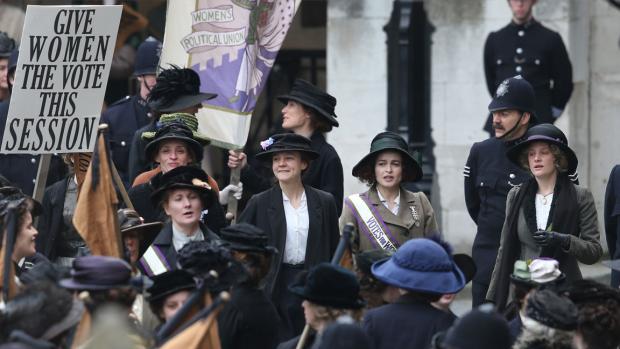More True Stories: Suffragette, The 33
In the past few years, I’ve spent a lot of time complaining about movies based on true events that played fast and loose with those events, ignoring facts that don’t fit into the dramatic structure or inventing characters and incidents. Of course, there’s a reason why filmmakers do that: They’re trying to make the movie more interesting. Whether pleasing an audience is worth what some might call lying to them is an open debate, but there’s no denying that audiences are much more likely to come see a movie if you pump up the entertainment factor. And that this isn’t as easy to do as it sounds is demonstrated by two more new movies based on true stories.
Hearkening as it does to a time and place when a substantial portion of a country’s population risked their liberty to fight for the right to vote, Suffragette arrives in theaters at a most ironic time, a week after an election in which approximately one quarter of eligible voters bothered to go to the polls in Erie County.
But in London of 1912, women were persuaded that the vote mattered, and that it was a way to improve their lot in life, which if you weren’t upper class was pretty dismal. Decades of peaceful campaigning have come to naught, so women’s groups began to take to civil disobedience, breaking store windows and blowing up postal boxes.
At the center of the story is Maud Watts (Carey Mulligan), a working- class wife and mother who has been toiling in a laundry since she was 12. Initially uninterested in suffrage, she is drawn into the movement after she witnesses police brutally beating woman at a demonstration. If she thought he life was bad before, it’s only going to get much worse.
Maud is fictional, but Suffragette includes a variety of real characters, including Helena Bonham Carter as a pharmacist who uses her knowledge of chemistry to make bombs and Meryl Streep in a cameo appearance as the leader-in-hiding Emmeline Pankhurst. Perhaps it’s a good thing that the issue of whether women should have the right to vote is so settled, at least in Western countries, that the film has trouble making an impact. On the other hand, it’s almost certainly a bad thing that modern viewers watching this history lesson are unlikely to share these activists’ conviction that the right to vote will enable them to improve things for oppressed workers: It’s a nexus writer Abi Morgan (The Iron Lady) relentlessly implies but never establishes.
***
It has only been five years since the Copiapó mining accident in Chile, in which 33 men were trapped 2,400 feet underground after a 120-year-old mine collapsed. The fact that many viewers will remember the outcome of that incident robs The 33 of much of the tension it might have had. Nor does it help that the men who came out of that mine agreed to keep secret certain difficult moments some of them had at the worst parts of their ordeal: laudable, of course, but it makes the movie awfully bland. We have little idea of what they do to pass their time while waiting for a rescue. Obviously there wasn’t much they could do, trapped in a small space with little food, but that’s an inherently dramatic situation that the film inexplicably skirts. Even reading the Wikipedia account of the accident and its resolution suggests a lot more drama than is onscreen here.
An international co-production, The 33 peppers its cast with recognizable faces from around the globe, including Antonio Bandaras, Rodrigo Santoro, Lou Diamond Phillips, Gabriel Byrne, and Juliette Binoche. But what makes this English-language film more than a bit ridiculous is that it insists on having all of these characters speak English with thick Latin American accents. I guess the filmmakers were afraid that we’d forget they were Chilean if they didn’t all sound like banditos in a spaghetti Western.

